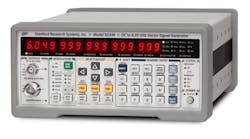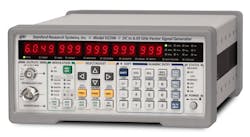Vector Signal Sources Reach 6.05 GHz
This file type includes high resolution graphics and schematics when applicable.
Signal sources for test-and-measurement purposes must be clean, accurate, and flexible. The SG390 Series of vector signal generators (VSGs) from Stanford Research Systems includes models with top frequencies of 2.025, 4.050, and 6.075 GHz. Each boasts excellent spectral purity and is capable of producing output signals with analog and vector in-phase/quadrature (I/Q) modulation. Thus, they can precisely replicate the types of modulated signals found in modern communications systems.
The SG390 Series of VSGs (see figure) includes model SG392, with output-power range of -110 to +16.5 dBm from 950 kHz to 2.025 GHz; model SG394, with output-power range of -110 to +16.5 dBm from 950 kHz to 4.050 GHz; and model SG396, with output-power range of -110 to +16.5 dBm from 950 kHz to 6.075 GHz. All three models also provide a BNC output port for signals from DC to 62.5 MHz, with harmonic and spurious levels controlled to -40 and -75 dBc, respectively, for those low-frequency output signals. All three VSGs offer 1 μHz frequency resolution at any frequency, with better than 8 ms switching speed to within 1 ppm of a tuned frequency.
Standard models are equipped with an oven-controlled crystal oscillator (OCXO) timebase with aging rate of better than ±0.05 ppm/year. When greater precision is needed, the signal sources are available with an oven-controlled rubidium timebase with aging rate of better than ±0.001 ppm/year, as Option 04. Each unit also includes an input port for a 10-MHz external timebase.
The VSGs are based on a frequency synthesis technique the company has named Rational Approximation Frequency Synthesis (RAFS). The approach employs small integer divisors in a conventional phase-locked-loop (PLL) source circuit to synthesize a signal close (about ±100 ppm) to the desired frequency, using the PLL’s reference oscillator for stability. The PLL uses the voltage-controlled OCXO which is phase locked to a dithered direct-digital synthesizer (DDS), and is adjusted so that the PLL can generate the exact required frequency.
Of course, the true power of the SG390 Series VSGs lies in their modulation capabilities, and these frequency-agile test-signal sources can produce amplitude modulation (AM), frequency modulation (FM), phase modulation, and pulse modulation, using an internal modulation source as well as a coaxial input port for an external modulation source. For simplicity, the VSGs provide presets for many standard modulated signals, including for GSM, EDGE, W-CDMA, NADC, DECT, and numerous other wireless communications standards.
The VSGs produce vector signal generation for carriers from 400 MHz to 6.075 GHz using a dual arbitrary waveform generator (AWG). These baseband signals are modulated onto the higher-frequency RF/microwave output signals by standard I/Q techniques within each VSG. The modulation generators can produce a wide range of vector modulation formats, including amplitude-shift-keying (ASK), frequency-shift-keying (FSK), quadrature-phase-shift-keying (QPSK), 8-state phase-shift-keying (8PSK), 8-state vestigial-sideband-modulation (8VSB), and 16-state-vestigial-sideband-modulation (16VSB) formats.
The VSGs can accomplish continuous sweeps from DC to 62.5 MHz, and sweeps across greater than octave ranges at higher frequencies. They incorporate support for all the standard pulse-shaping filters used in digital communications, including raised-cosine, root-raised-cosine, Gaussian, rectangular, and triangular filters. These test signal sources also allow for controlled injection of additive white Gaussian noise (AWGN) into the signal path.
As impressive as the modulation capabilities of these sources, they are also high-performance signal generators, with typical phase noise of -80 dBc/Hz offset 10 Hz from the carrier, -102 dBc/Hz offset 1 kHz from the carrier, and -130 dBc/Hz offset 1 MHz from the carrier. They provide phase control of ±360 deg. maximum phase step with 0.01 deg. phase resolution for DC to 100 MHz, 0.1 deg. resolution for 0.1 to 1.0 GHz, and 1 deg. resolution for 1.0 to 8.1 GHz.
Stanford Research Systems Inc., 1290-D Reamwood Ave., Sunnyvale, CA 94089; (408) 744-9040, FAX: (408) 744-9049.
This file type includes high resolution graphics and schematics when applicable.


